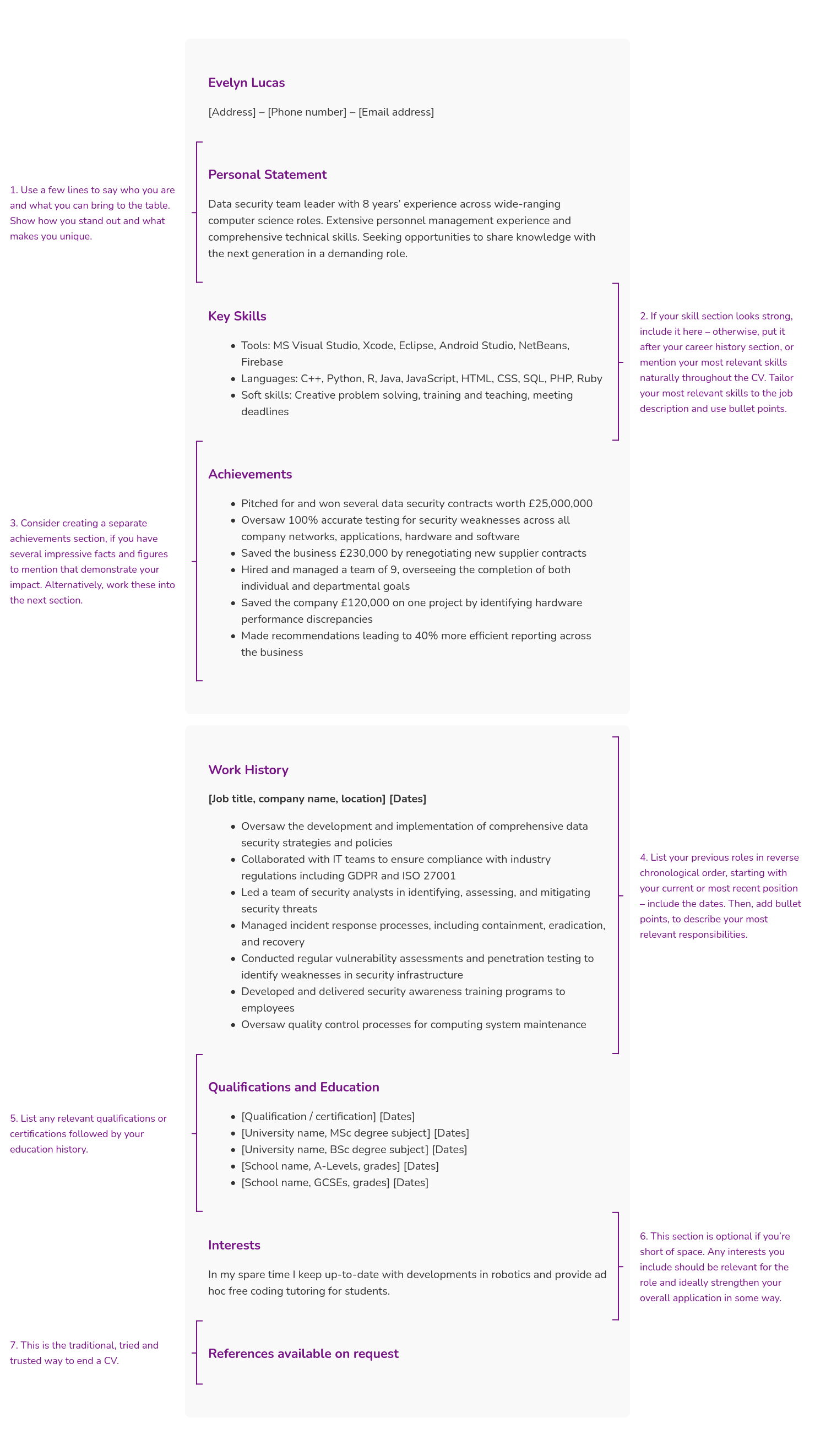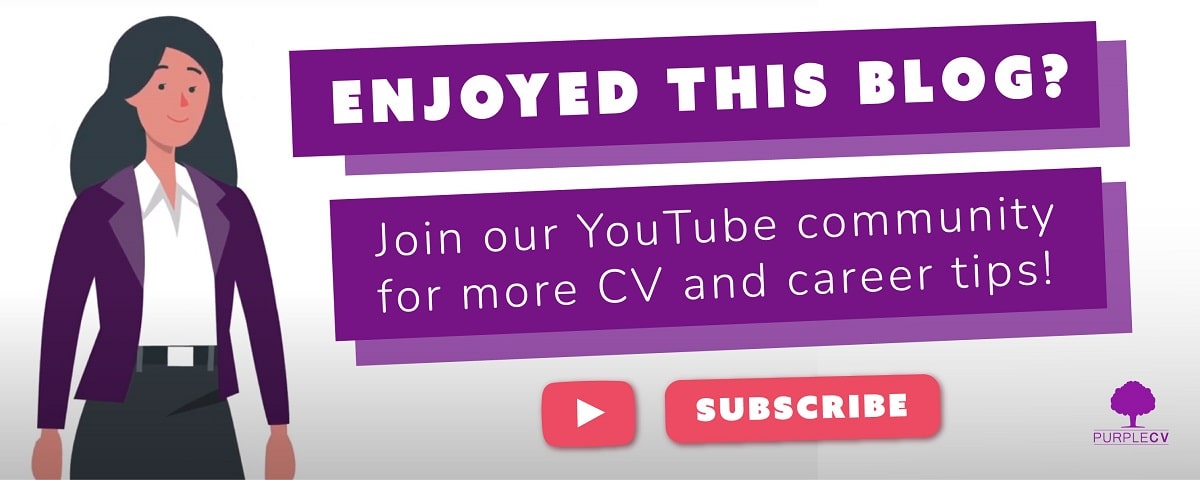Want to write a new computer science CV, or improve your old one, but not sure where to start?
In our latest guide, we’ll outline how to efficiently put together a computer science CV that does you justice and gives hiring managers what they’re looking for.
We’ve also written a computer science CV example to show you where everything goes!
Whether you want to work as an app developer or security specialist, for a social media firm or a government department, there are many possibilities for computer scientists.
With such a wide range of career paths, computer science skills tend to be in high demand and you can expect to receive a decent salary during your career.
For example, according to the National Careers Service experienced software developers, data scientists and computer games developers can earn around £70,000 a year.
Competition will be intense for the best roles though, so take time writing your CV to give yourself the best chance of success.
The basics of a strong computer science CV
In some ways, a computer science CV isn’t any different to one for any other industry. There are a few basics you need to get right.
If you’re starting from scratch, here’s our full guide to writing a CV and a few general points:
- Use a clear structure
- Avoid complicated formatting
- Don’t make any spelling mistakes
- Send it as a PDF to maintain its appearance
When you’re close to finishing, try to come up with a strong headline and make sure your CV has a sensible ending.
How to write a computer science CV
Your master computer science CV should have these sections:
- Contact details
- Personal statement
- Key skills
- Work history
- Qualifications and education
- Interests (optional)
If you’re applying for several open positions, there’ll be some text you can re-use each time. There’s no need to change your contact details of course and in many cases, you can keep some of the text for your personal statement, work history, skills and qualifications.
However, we always recommend tailoring your CV to the job description of the vacancy you apply for. Depending on what’s most relevant for your target employer, you may need to pick and choose which career highlights you draw the most attention to.
We also recommend backing up any achievements you mention with facts or statistics.
For example – can you quantify how much money you made or saved for a company? By what percentage did you improve something? How many people have you managed?
Adding the right skills to your computer science CV
Given the broad range of careers open to computer scientists, there’s a vast array of skills that could be relevant on your CV.
For some roles, the priority will be specifying the programming languages you’ve mastered – Python, C++ and the like. For others, it will be more about listing which coding tools you can use – whether that’s Microsoft Visual Studio, Eclipse or other programs.
A good place to start is by analysing the job advert or description for the vacancy you are applying for. It should specify which skills are required and which ones are nice-to-haves.
Tailor your computer science CV to the role – highlight the skills your potential employer will want to see. This should also help ensure your CV bypasses companies’ ATS software too.
Alternatively, if you’re creating a master computer science CV without a specific job vacancy in mind and you’re not sure how to display lots of skills, group them into themes.
Examples of skill groups could include:
- Coding tools
- Programming languages
- Software development
- Database management
- Technologies
- Natural language processing
- Technical writing
- Problem solving
- Experimentation
- Data analysis
- AI
- Statistics
- Mathematics
Think about where your expertise lies and how best to group your skills.
We’ve included a draft skills section in our computer science CV example.
Computer science CV example

Evelyn Lucas
[Address] – [Phone number] – [Email address]
Personal Statement
Use about 6-7 lines to outline who you are, what you can offer and your career goals.
Be concise, but explain how you stand out. Here are a few sample sentences:
Data security team leader with 8 years’ experience across wide-ranging computer science roles. Extensive personnel management experience and comprehensive technical skills. Seeking opportunities to share knowledge with the next generation in a demanding new role.
Key Skills
Relate your skillset, achievements and areas of expertise to the job description and use bullet points – for example:
- Tools: MS Visual Studio, Xcode, Eclipse, Android Studio, NetBeans, Firebase
- Languages: C++, Python, R, Java, JavaScript, HTML, CSS, SQL, PHP, Ruby
- Soft skills: Creative problem solving, training and teaching, meeting deadlines
Work History
List your previous roles and experiences, in reverse chronological order, starting with your current or most recent position and including the dates.
Add bullet points to describe your most relevant achievements or responsibilities – for example:
[Role, company] [Dates]
- Pitched and won several data security contracts worth £25,000,000
- Oversaw 100% accurate testing for security weaknesses across all company networks, applications, hardware and software
- Saved the business £230,000 by renegotiating new supplier contracts
- Hired and managed a team of 9, overseeing the completion of both individual and departmental goals
[Role, company] [Dates]
- Oversaw quality control processes for computing system maintenance
- Saved the company £120,000 on one project by identifying hardware performance discrepancies
- Made recommendations leading to 40% more efficient reporting across the business
Qualifications and Education
In reverse chronological order, list any relevant qualifications or certifications followed by your education history:
- [Qualification / certification] [Dates]
- [University name, MSc degree subject] [Dates]
- [University name, BSc degree subject] [Dates]
- [School name, A-Levels, grades] [Dates]
- [School name, GCSEs, grades] [Dates]
Interests
This section is optional if you’re short of space. Any interests you include should be relevant for the role and ideally strengthen your overall application in some way – for example:
In my spare time I keep up-to-date with developments in robotics and provide ad hoc free coding tutoring for students.
References available on request
Writing a graduate computer science CV
If you’ve just left university and don’t have much or any work history to write about yet, there are a few ways you can adapt a graduate computer science CV.
You could write about any impressive projects you’ve worked on, any recent internships or placements you’ve had or any voluntary work you’ve completed that’s relevant to the role.
Consider tweaking the overall format by using a functional CV – one that’s skills-based rather than designed around the usual reverse chronological style.
Regardless of how much experience you have, our final recommendation is to include a cover letter with your computer science CV, even if the job advert doesn’t ask for one.
We’ve written about how to write a great cover letter that impresses hiring managers.
Summary: computer science CV
Here’s a quick recap of our main guidelines for writing a computer science CV:
- Create a master CV document and then, for every new role you apply for, make a copy and tailor it to the job advert (also take any ‘copy of’ text out of the filename!)
- Analyse the requirements for the role and choose which of your achievements or skills to highlight accordingly
- Check each CV thoroughly to correct any mistakes and send it as a PDF
If you need any help, look no further – we can write a computer science CV for all experience levels, so please get in touch for more information.


